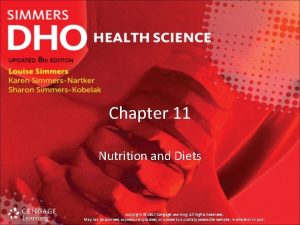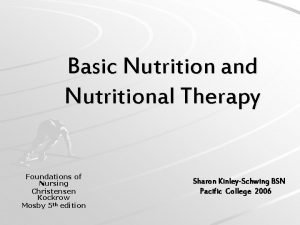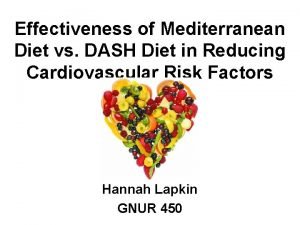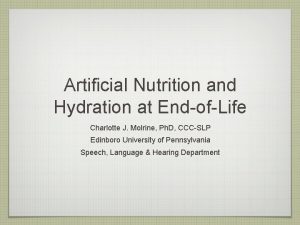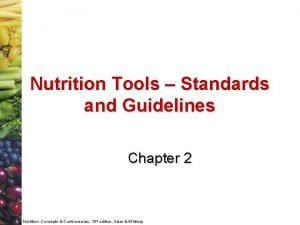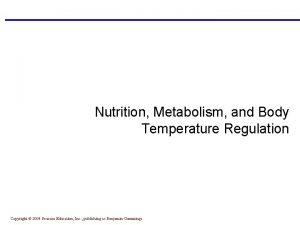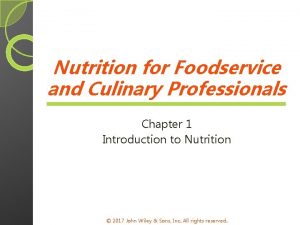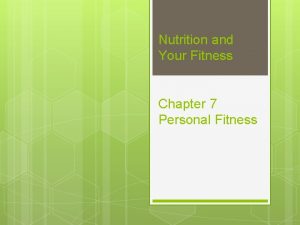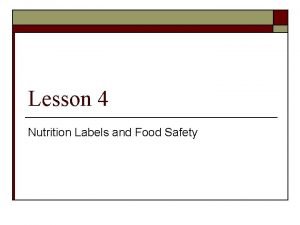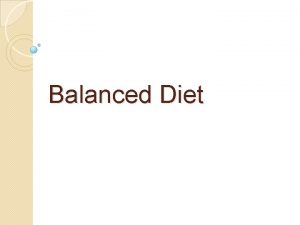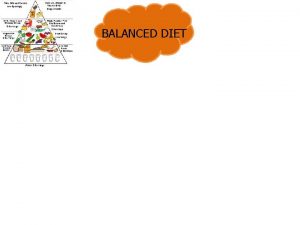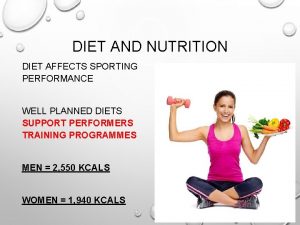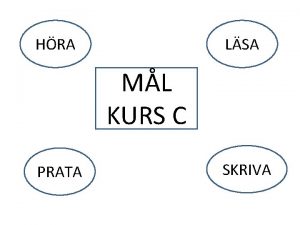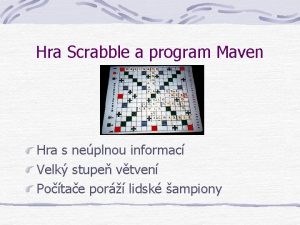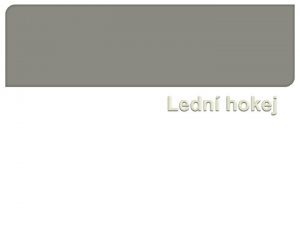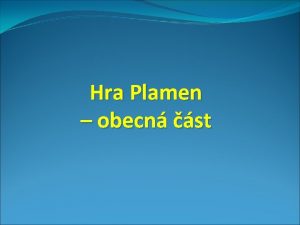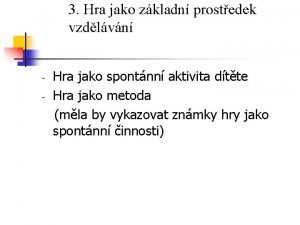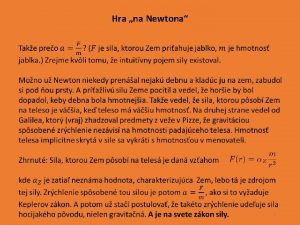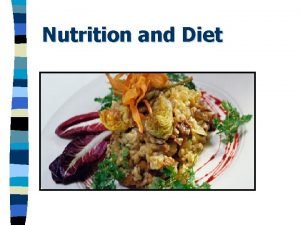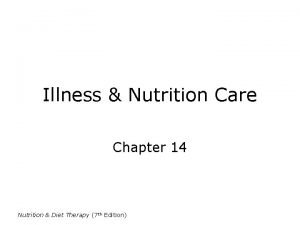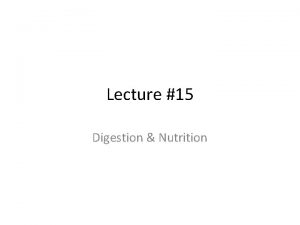HRA DIET AND NUTRITION Diet is what we

























- Slides: 25

ĀHĀRA DIET AND NUTRITION

Diet is what we intake; whether it is food, water or air on the bodily level and it can be what our senses intake – what we smell, taste, see, touch, hear. n Nutrition is what - out of our diet (intake) actually reaches the target (organs/ tissues) and contributes to their growth and development. n n So what is the difference between the two? One is what we intake (diet) and the other is what we are capable of digesting and making available to our ‘system’. What does it take for diet to be converted into nutrition? Before we go into this, let us take a look at some basic principles…

Basic principles in brief: n Pāncabhautik siddhanta (Law of 5 elements): Everything in the universe is pāncabhautik, made up of the five basic elements – pṛthvi, āpa, teja, vāyu, ākāśa. All the 5 elements essentially exist in every substance. Depending on the dominance of a particular element, it is called earth dominant, water dominant so on and so forth. But each substance essentially has all the five elements.

n For example, a stone is earth dominant but since it has a certain shape and size it will necessarily have ākāśa as well. We know some stones are softer that others. This comes from water content. Its porosity will contribute to its air and space content. Its luminosity/ colur/ shine and its inherent heat will contribute to its fire element.

n Pṛthvi or Earth dominant substances are characterized by their being guru (heavy), khara (rough), kathiṇa (hard), manda (opposite of sharp, piercing; also means slow acting), sthira (stable), viṣada (dry, clean of any adherance), sāndra (dense), sthūla (macro or large).

n Āpa or Water dominant substances are characterized by their being drava (liquid), snigdha (unctuous or oily), śita (cold), manda (slow acting), mṛdu (soft), picchil (slimy), sara (fluid).

n Agni or Fire dominant substances are characterized by their being ūṣṇa (hot), tikṣṇa (piercing or sharp), sūkṣma (micro or extremely small), laghu (light), rukṣa (dry), viśada (dry, clean of any adherence); prabha (light or radiance).

n Vāyu or air dominant substances are characterized by their being laghu (light), śīta (cold), rukṣa (dry), khara (rouagh), viṣada (dry and clean of any adherence), sūkṣma (micro or extremely small).

n Ākāśa or space dominant substances are characterized by their being mṛdu (soft), laghu (light or extremely low weight as ākāśa is space), sūkṣma (micro), ślakṣṇa (smooth/fine). Pure ākāśa is absence of mass and hence there is no friction, resulting in smoothness.

Loka puruṣa siddhanta (Law of Macrocosm-microcosm relationship): n The body as a microcosm is a reflection of the universe, the macrocosm. Everything, every process that exists in the universe, exists and is reflected in the body. n Example: Just as the Sun is at its height at noon, so also the agni in the body is at its height at noon…

Sāmānya – Viśeṣa siddhanta (Law of similarity-dissimilarity): n Similarity breeds similarity. n Example : adding fire to fire will increase a fire. Adding water (which is opposite in qualities to fire) will reduce a fire.

Anna praśastī (Significance of a proper diet): n Caraka Samhita (an ayurvedic classical text) says, “Diet is the prāṇa – the life force - of all living organisms. All living organisms strive for food. Food has the potential of supporting life, varṇa (complexion), sauswarya (strong voice), pratibhā (charisma), sukha (happiness), tuṣṭi/puṣṭi (satisfaction), bala (strength), medhā (intellect)…”

n But for this diet to become - nutrition, it has to be first properly digested, absorbed and assimilated into the body…

Pacana Digestion or transformation All transformation is essentially due to agni or the fire element. n For example: Unripe fruits when kept in warm environs ripen. This is transformation. This is the principle for incubators as well… to ripen or to cause maturity by gentle heating. Grains of rice are inedible. They are heated with water – action of agni - to ‘cook’ or transform them into an edible form. n So fire (heat) essentially transforms or processes or digests. The above examples are from the universe, the macrocosm. n

n Whatever we intake as food, water etc is ‘foreign’ to the body. It has to be converted or transformed into body absorbable, body compatible form and finally into dhātu (body tissues) and various other body components. In our body - the microcosm, agni or fire element transforms, processes or what we call ‘digests’ the diet that we consume and converts it into nutrition.

Nutrition for various body components n There an infinite number of body components. But grossly, let us consider the 7 dhātu or 7 body tissues.

No. Dhatu Analogical to Element dominance 1 Rasa Plasma Water 2 Rakta Blood Fire 3 Mamsa Muscle Earth, water 4 Meda Fat Water, earth 5 Asthi Bone Earth 6 Majja Nerve Water, earth 7 Sukra Reproductive tissue Earth, water – Males Sperm in males Fire, water – Females Ova in females

Examples: 1. Māṃsadhātu (muscle tissue). Its function is movement, carrying the weight of the body, and strength of holding and ‘working’. It needs strength, stability, endurance that comes from earth. At the same time, it cannot have the stiffness of earth, hence some water element to give it elasticity is also needed. n 2. Asthi dhātu (bone). Its basic nature is earth dominant. More the earth, better is the compactness and strength of the bone. On the contrary, increase in air/space, more the osteoporosity, weaker the bone in compactness and strength.

n For a healthy body our diet should be balanced – should contain the correct amount and percentage of the 5 elements in the form of diet AND n The agni (fire) should be strong enough to digest it to give nutrition to the various body tissues. IF properly digested, it can be transformed into the correct quantity, quality of body tissues that have the correct functionality. n Strong fire and strong dhātu amount to strong immunity.

Some simple spices to improve digestion: n Coriander seeds powder -improves fire and digestion capacity n Cumin seeds powder -improves fire (digestion capacity), improves peristalsis n Ajwain (Indian celery) powder -improves fire, reduces gases

n Black pepper powder -improves fire, reduces kapha and heaviness n Ardrak (fresh ginger) -improves fire, reduces constipation, helps proper stools n Shunthi (dry ginger) -improves fire, reduces loose motions, improves stools

Āhāra-vidhi-viśeṣāyatan These are 8 ‘factors’ or issues that need to be considered about āhāra (diet). 1. Prakṛti (constitution) of the food consumed. Every substance that is consumed has a set of different qualities like light/ heavy; cooling/hot; snigdha/rukṣa etc. These qualtities define the constitution of the food, which has to be considered with reference to the person consuming it. 2. Karaṇa means saṃskāra – putting together or preparing that results in the change in qualtities of the substance. Grinding, roasting, boiling, cooking are various karaṇa to make diet more available… n

n n Kāla means time. Time would refer to season (diet would need to be changed according to season; one wouldn’t eat śita food in winter); time would also refer to time of day… lunch should be relatively heavy as compared to dinner; time would also refer to the age of the person. The quality and quantity of diet would change according to the age of the person… etc Deṣa means the locale or place. Location of the origin of the food substance as well as the location of its comsumption. Eg. locally available ‘usṇa’ mustard oil in north India, Himalayan plains… locally available ṣita (cooling) coconut oil in the hot tropical coastal southern India.

n Saṃyoga – combination of substances. Eg. combining milk and sugar is excellent whereas combining fish and milk is reason for a number of diseases… esp skin diseases… n Rāśi (quantity) to be consumed. Generally imagining the stomach into 4 parts; consuming 2 parts solids, 1 part liquid, 1 part empty… or according to another sage… 1 part solid, 1 part liquid, 1 part empty…

n Upayoga niyama are the dietary rules to be followed. For example, Food should be warm, it should be snigdha (unctuous) not too dry; one should not eat before the previous meal has been completely digested; should eat in a clean and sanitary place; should not talk too much while eating; eat with love, gratitude and peace; not too fast, not too slow… etc n Upayoktā or the consumer – the person who is eating. His prakṛti, his constitution, his digestion capacity, his requirement, his age, his preferences etc need to be taken into account while deciding the diet.
 Test chapter 11 nutrition and diets
Test chapter 11 nutrition and diets Chapter 11 nutrition and diets
Chapter 11 nutrition and diets Nutrition fundamentals of nursing
Nutrition fundamentals of nursing Objective of hra
Objective of hra Mediterranean diet vs dash diet
Mediterranean diet vs dash diet Lev and schwartz model
Lev and schwartz model Hra radiation assurance
Hra radiation assurance Oca125 login
Oca125 login Doh 5178a
Doh 5178a My benny card ibew
My benny card ibew Pelican hsa 775
Pelican hsa 775 Frital
Frital Mid america hra
Mid america hra Darb medicaid
Darb medicaid Riskuj pravidla
Riskuj pravidla Cdh account optum
Cdh account optum Jehlan s trojúhelníkovou podstavou
Jehlan s trojúhelníkovou podstavou Community coverage w/cbltc
Community coverage w/cbltc Airsoft hra
Airsoft hra Pros and cons of artificial nutrition and hydration
Pros and cons of artificial nutrition and hydration Illuminate aqa food
Illuminate aqa food Nutrition tools standards and guidelines
Nutrition tools standards and guidelines Homeostasis mechanisms for regulation of body temperature
Homeostasis mechanisms for regulation of body temperature Nutrition for foodservice and culinary professionals
Nutrition for foodservice and culinary professionals Kelsey carbonetta
Kelsey carbonetta Lesson 4 nutrition labels and food safety
Lesson 4 nutrition labels and food safety
